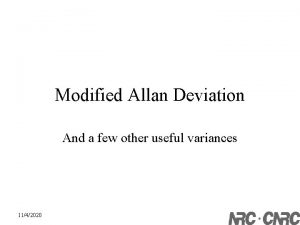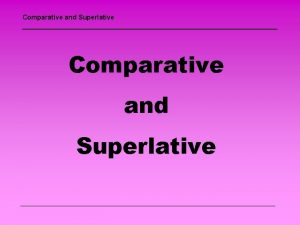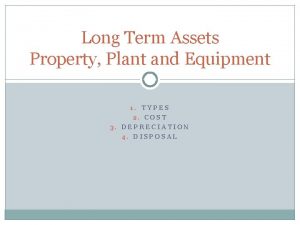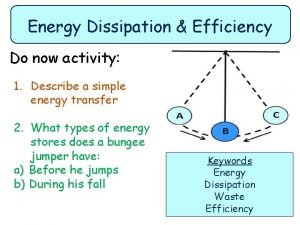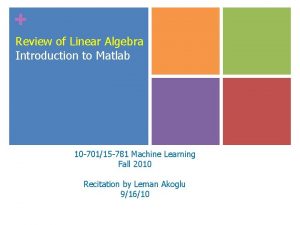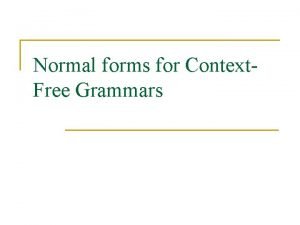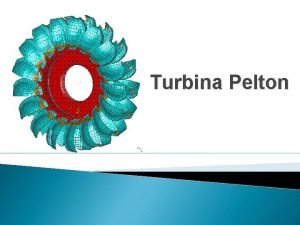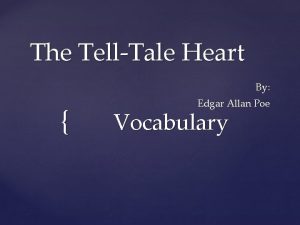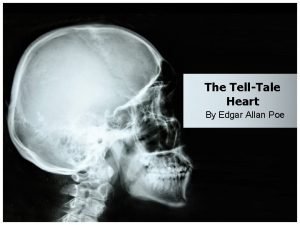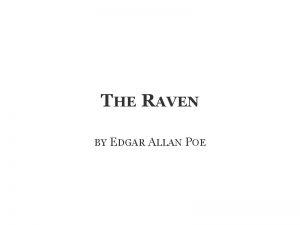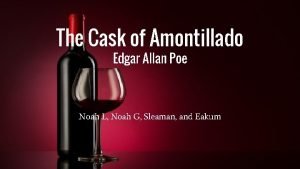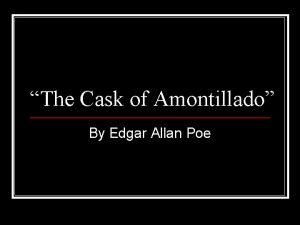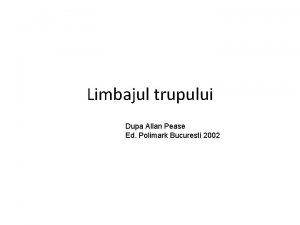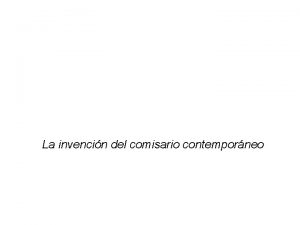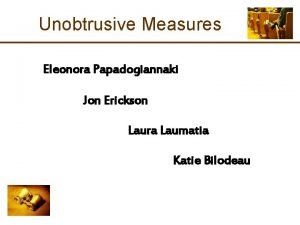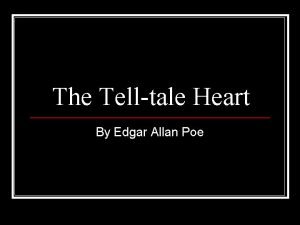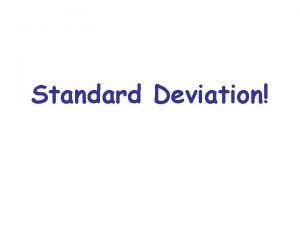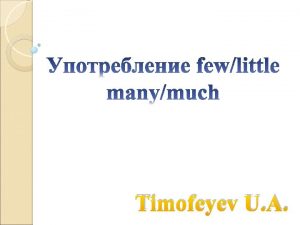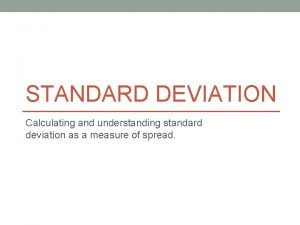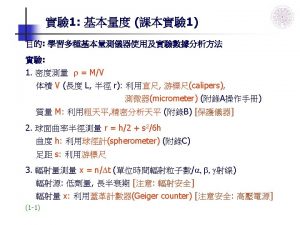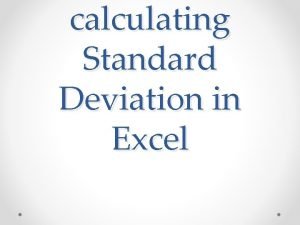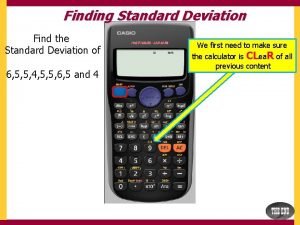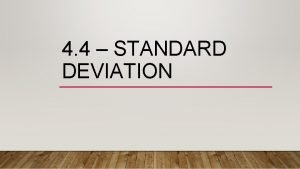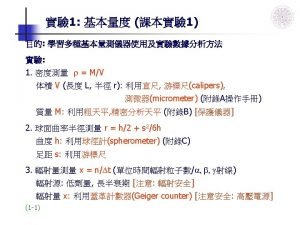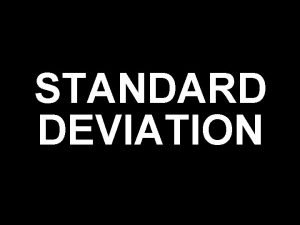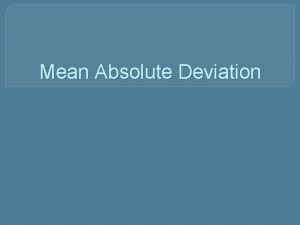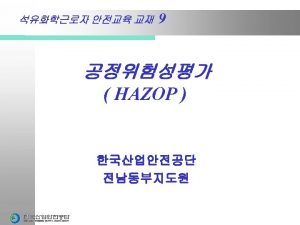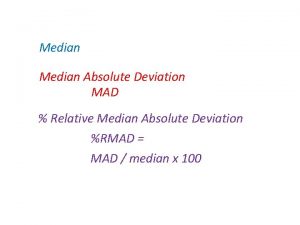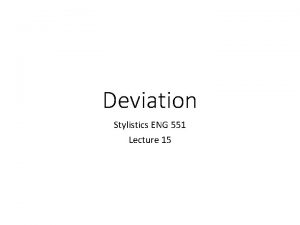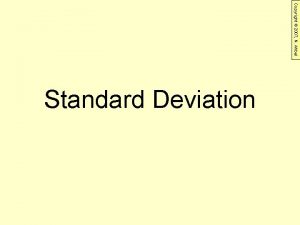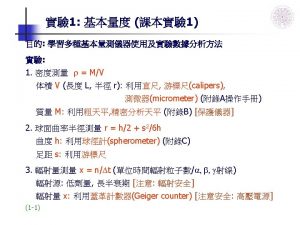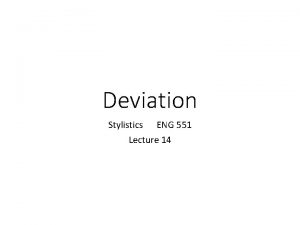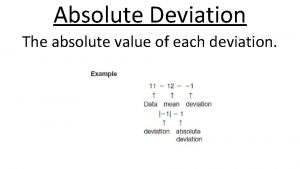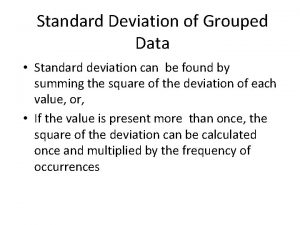Modified Allan Deviation And a few other useful









































- Slides: 41

Modified Allan Deviation And a few other useful variances 11/4/2020

ADev • Equation: second differences • Why try other statistics? • Limited in discriminating white from flicker phase noise • Does not work well with drifting frequency signals 11/4/2020

Allan Variance for 2 pft >1 • White phase noise • Flicker phase noise • White frequency noise • Flicker frequency noise • Random walk N. B. f is the high frequency cutoff. 11/4/2020

Log(sy(t)) Power dependence of ADev White and flicker phase Ideally for white phase White frequency Flicker frequency Log(t) 11/4/2020 Random walk frequency

White Phase Noise 100 samples Blue: average 11/4/2020 Red one : one sample

ADEV of White Phase Noise Slope = -1 ! Not -3/2 ? !? ADev is not sensitive to white phase noise. It converts the short term noise into some sort of flicker phase noise. 11/4/2020

Filcker Phase Noise One sample in red average 11/4/2020 100 samples

ADev of Flicker Phase Noise Slope > -1 ADev does not measure flicker phase noise properly. There is an extra ln(t) factor. 11/4/2020

White phase + white frequency noise: looks like white flicker phase noise The sum of white phase and white frequency noises cannot be sorted out by ADev. 11/4/2020 The slope is slightly higher than -1, like the case of pure flicker phase noise.

Mod ADev • Equation second differences of average phases • Reduces the phase noise over the interval tau considered by averaging • White and flicker average differently Let’s compare ADev and Mod Adev 11/4/2020

ADev MOD ADev 11/4/2020

MOD ADev You may be reluctant to calculate MOD ADev because of the double summation but there are tricks: 11/4/2020

Practical way of calculating MOD Calculate the first D 2 average for n Initialize accumulator One loop only Update overlapping average Update accumulator Calculate MODsy for nt 0 11/4/2020

Example of MOD Adev shows that t--1 noise does not really exist. There is t— 3/2 and t— 1/2 noise. ADev Note the lower values for each type of noise, except maybe random walk frequency MOD Adev 11/4/2020

Is there more? Yes. • What about drift? – Hadamard variance will help solve it for us • What about long term? – Total. ADev is another interesting solution • What about time prediction? – TDev is the proper answer. 11/4/2020

Hadamard Using third difference gets rid of frequency drift. It can be used to compare with ADev in order to attempt to distinguish between random walk and frequency drift. Note the factor 6 at the denominator: since this is a second difference in frequency, you get 3!=6 gain of the original noise. Just to convince yourself, calculate the variance of a pure gaussian noise and its first, second and third differences. 11/4/2020

Example of Hadamard on drifting clock ADev Hadamard Drift has been removed to reveal the underlying noise 11/4/2020

Total variance • To improve the estimation for time intervals close to the time of measurements, a technique similar to what is assumed in FFT can be used. • Wrapping the data from the end to the beginning of the time series smoothes the results for long time intervals. 11/4/2020

How to realize Total ADev Very useful for long t 1 -Duplicate data Total ADev t t 2 -shift data to align ends 3 -Run ADev from t=0 to t=T/2 starting within the interval 0 -T 11/4/2020

TDev • Do we need more? • Frequency stability is not all • We need to determine where will be the clock after some time. • Using the MOD ADev, you get it 11/4/2020

Work in time : TDev Easy to compute once you can compute MODADev You can always use not too bad substitute for rough evaluation: 11/4/2020

Example of TDev From these ADev and MOD ADev below you get this TDev and sx(t) on the right s x (t ) ADev MOD ADev 11/4/2020 TDev

Before concluding • What if data is not equally spaced? – If intervals do not vary by more than 5%, it does not matter at all. We will see later. • What if data is missing? – Just use the time tag to skip the data in your statistics. No real need to interpolate. 11/4/2020

Not equally spaced data ADev Note that close to the main diagonal where the t 1 = t 2 there is a very slow change in the actual value of ADev log (t 2) ADev Random walk frequency log(t 1) log (t log( t 2 ) ADev White frequency log(t ) 1 11/4/2020 log(t 1) log ( log(t ) 1 2) ADev 2) t White/flicker phase Flicker frequency

Beware of long time measurements When you calculate ADev or any other over long time intervals, there may be some changes in the conditions of measurements 11/4/2020

Moving FFT I 11/4/2020

Closer look at the moving ADev The one second is fluctuating with time, due to some interference of some kind. Average value over the whole period is meaningless. 11/4/2020

Degrees of freedom For all types of noise the distribution is nearly 2 within a few percent. We can safely assume for the purpose of calculating the degrees of freedom that it is 2 distributed. In the case of white phase noise: The degrees of freedom associated with ADev, Mod. ADev, etc. can be estimated to be roughly the time span T-nt divide by t, where n is one for ADev and 2 for Mod. ADev. In the case of Total Dev, n=0. Ndof=(T-n*t)/t, n=0, 1 or 2 for ADev, Mod. ADev or Total. ADev For other type of noise, there is a reduction in the number of degrees of freedom going as low as 67% for white frequency noise and large degrees of freedom. Note that for Ndof cannot be lower than 1. Use this number for calculating the coverage factor. 11/4/2020

Degrees of freedom For all types of noise the distribution is nearly 2 within a few percent. We can safely assume for the purpose of calculating the degrees of freedom that it is 2 distributed. In the case of white phase noise: The degrees of freedom associated with ADev, Mod. ADev, etc. can be estimated to be roughly the time span T-nt divide by t, where n is one for ADev and 2 for Mod. ADev. In the case of Total Dev, n=0. Ndof=(T-n*t)/t, n=0, 1 or 2 for ADev, Mod. ADev or Total. ADev For other type of noise, there is a reduction in the number of degrees of freedom going as low as 67% for white frequency noise and large degrees of freedom. Note that for Ndof cannot be lower than 1. Use this number for calculating the coverage factor. 11/4/2020

conclusion • Again and again, use all the tools available to characterize your data. • Look at your data from different point of view. • All those tools are there to help you sortout the various problems of timekeeping. 11/4/2020

beware • TDev should be used carefully for prediction over interval different than the one estimated. • Better use the structure factors – A little bit of it follows 11/4/2020

phase Generalized Variance in the average frequency transfer 1 A 2 3 B 4 time 11/4/2020

Standard uncertainty In theory you need to measure those h coeficients 11/4/2020

Useful results Knowing , we want with the following form: where each type of noise is calculated independently. 11/4/2020

What f. A-B are • AB structure factors which are directly linked with the measured Allan deviation. • Can be used for any linear combination of results in the calibration interval. • For end-point average frequency, results simple enough for hand-calculator use. • Provided similar equipment (same high cutoff frequency) is used, no dependence on passband. 11/4/2020

Ratio 2 of uy a to for 2 pft >1 • White and flicker phase noise • white frequency noise • flicker frequency noise • random walk 11/4/2020 Adeva 2

Time prediction reference Clock A 11/4/2020

Timescale work • Prediction of uncertainty of time after interval t. B • following calibration over interval t. A • equivalent to prediction of frequency uncertainty on t. B after calibration on t. A with no dead time. 11/4/2020

Time error after calibration of a hydrogen maser 11/4/2020

Ratio of time error to Adev*t no random walk FM 11/4/2020

Ratio of time error to Adev*t (with random walk FM) 11/4/2020
 She is lucky she has few problems
She is lucky she has few problems Few a few ero
Few a few ero Few, a few, little, a little exercise
Few, a few, little, a little exercise Use these words to complete the sentences
Use these words to complete the sentences Modified allan variance
Modified allan variance Measures of variability
Measures of variability Types of position
Types of position Classify the different materials as useful or harmful
Classify the different materials as useful or harmful What happened to poe's biological father
What happened to poe's biological father Comparison of adjectives comfortable
Comparison of adjectives comfortable Vilfredo pareto
Vilfredo pareto Useful life of property plant and equipment
Useful life of property plant and equipment Useful and harmful microbes
Useful and harmful microbes Net book value
Net book value Useful life of property plant and equipment
Useful life of property plant and equipment What is thermal energy
What is thermal energy Old and new matrix algebra useful for statistics
Old and new matrix algebra useful for statistics What are useful and useless symbols in grammar
What are useful and useless symbols in grammar Energy transfer to surroundings grade 7
Energy transfer to surroundings grade 7 What is data converted into a meaningful and useful context
What is data converted into a meaningful and useful context Lester allan pelton
Lester allan pelton Poe
Poe The tell tale heart theme
The tell tale heart theme Edgar allan poe tell tale heart summary
Edgar allan poe tell tale heart summary Richard p. allan
Richard p. allan The raven narration
The raven narration The raven edgar allan poe meaning
The raven edgar allan poe meaning The conqueror worm poem
The conqueror worm poem Plot of the cask of amontillado
Plot of the cask of amontillado Edgar allan poe freemason
Edgar allan poe freemason Cask of amontillado litcharts
Cask of amontillado litcharts Timeline of edgar allan poe
Timeline of edgar allan poe Allan seppänen
Allan seppänen Lester allan lasrado
Lester allan lasrado Allan pease limbajul trupului
Allan pease limbajul trupului Mel bochner
Mel bochner Gateways to art: understanding the visual arts
Gateways to art: understanding the visual arts Horacio quiroga edgar allan poe
Horacio quiroga edgar allan poe Post cholecystectomy syndrome treatment
Post cholecystectomy syndrome treatment Varianza de allan
Varianza de allan Allan laumatia
Allan laumatia The anticipation poe
The anticipation poe




